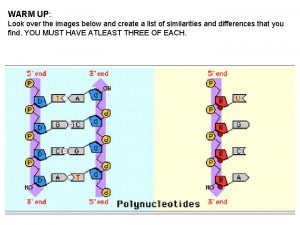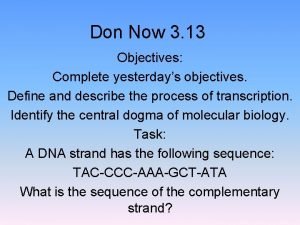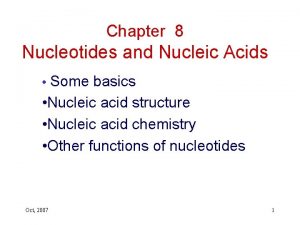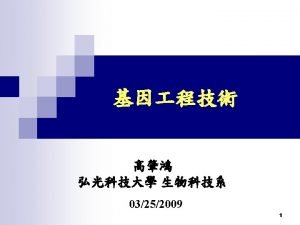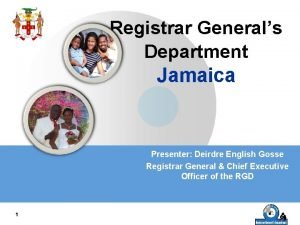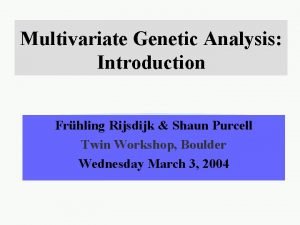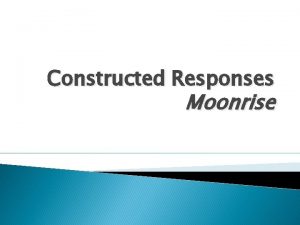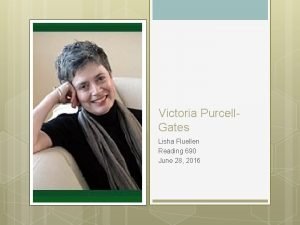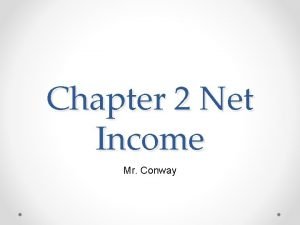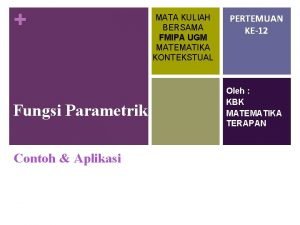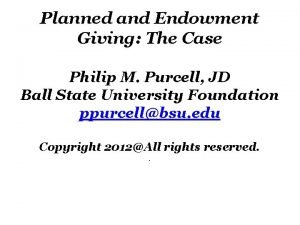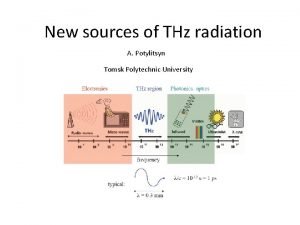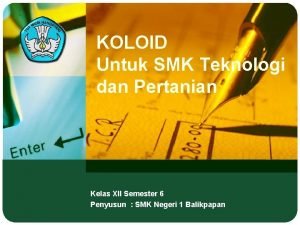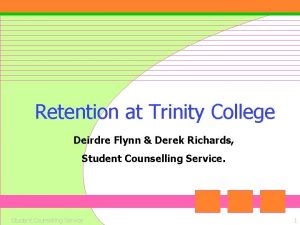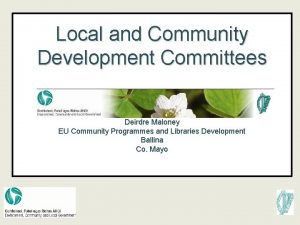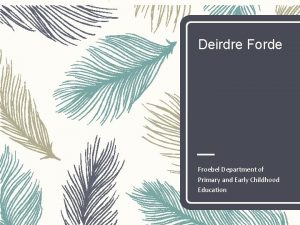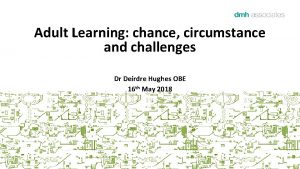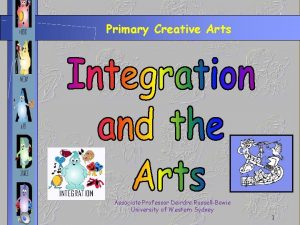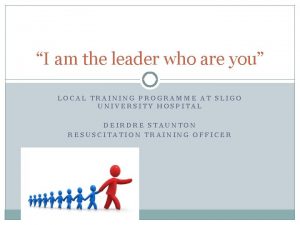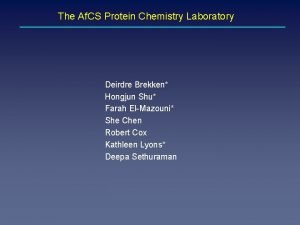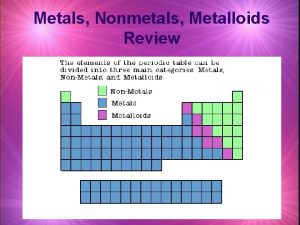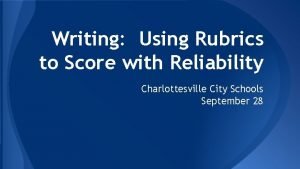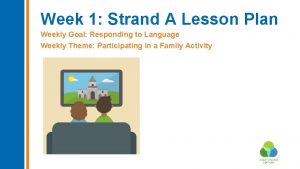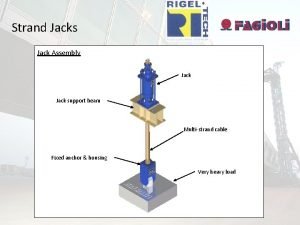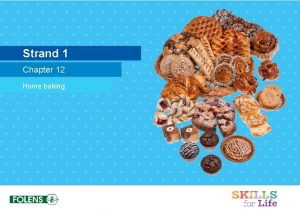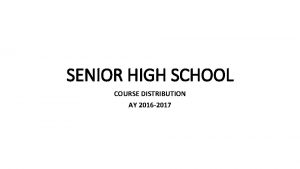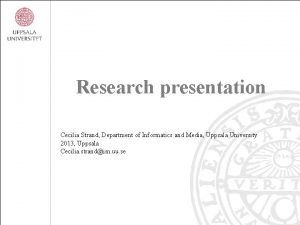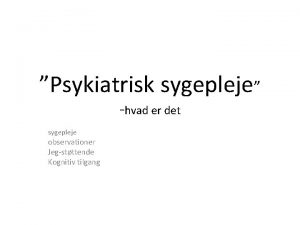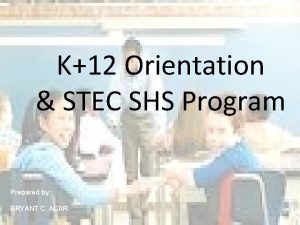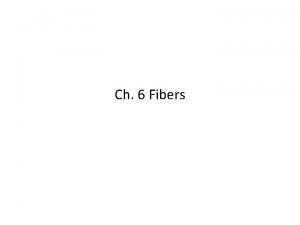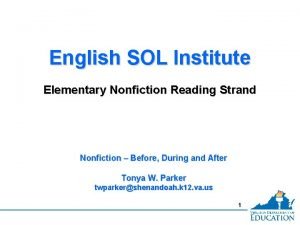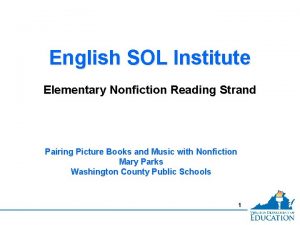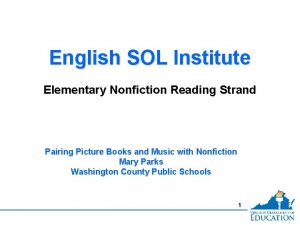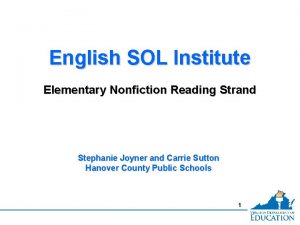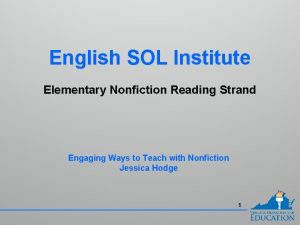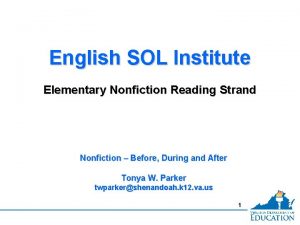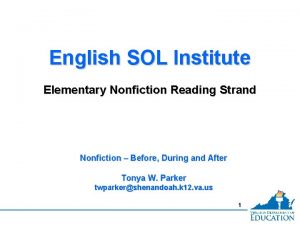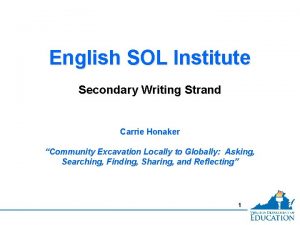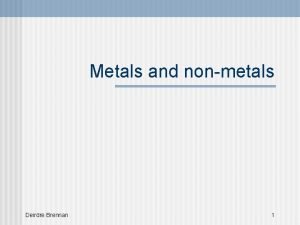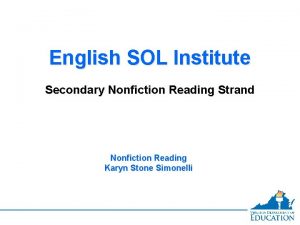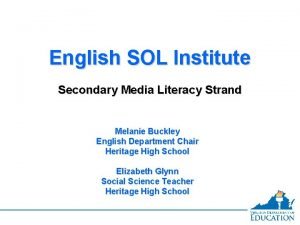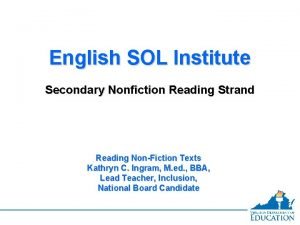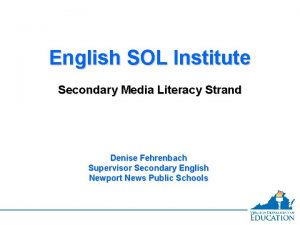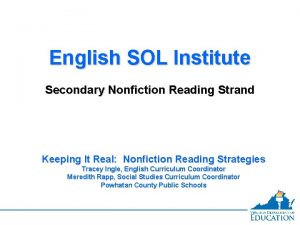English SOL Institute Elementary Writing Strand Deirdre Purcell


























































- Slides: 58

English SOL Institute Elementary Writing Strand Deirdre Purcell, NBCT Third Grade Teacher, Chesapeake Public Schools 1

Elementary Writing Key Points in Writing • Writing to convey a concise message begins in Kindergarten and moves through grade 3 when students will write a short report • Student use of graphic organizers begins at grade 1 • Beginning in grade 4, students write multiparagraph essays 2

Elementary Writing Key Points in Writing • Persuasive writing begins in 5 th grade • Students in grades 3 -5 should have practice writing on demand, for shorter time frames, and over extended periods of time 3

Elementary Writing ~ Kindergarten New to the Standards: K 12) The student will write to communicate ideas for a variety of purposes K 12 a) Differentiate pictures from writing K 12 b) Draw pictures and/or use letters and phonetically spelled words to write about experiences K 12 c) Use letters and beginning consonant sounds to spell phonetically words to describe pictures or write about experiences

Implementation in Kindergarten Write to communicate ideas for a variety of purposes: ? Write questions Captioning pictures Exit cards after lessons Journaling

Implementation in Kindergarten Draw pictures and/or use letters and phonetically spelled words to write about experiences: Brainstorm Experiences: ~going to the zoo ~riding a school bus ~visiting a friend ~watching a movie ~making a friend ~swimming ~going to the park ~helping to cook Draw picture of the experience Label picture here Teacher models through shared writing experiences.

Elementary Writing ~ First Grade New to the Standards: 1. 12 a) Form letters accurately 1. 12 b) Space words within sentences 1. 12 c) Use the alphabetic code to write unknown words phonetically 1. 13) The student will write to communicate ideas for a variety of purposes 1. 13 c) Revise by adding descriptive words when writing about people, places, things, and events

Elementary Writing ~ First Grade 1. 13 f) Use correct spelling for commonly used sight words and phonetically regular words in final copies 1. 14) The student will use available technology for reading and writing

Implementation in First Grade Use the alphabetic code to write unknown words phonetically. ~Continued practice with phonemic spelling ~Encouragement to write unknown words based on their letter sounds ~Weekly spelling sorts to reinforce letter sounds ~Replacing first letter with a new consonant to create new words (onsets and rimes ~ word families)* *This is especially engaging when done on the Smartboard so students can manipulate letters

Implementation in First Grade The student will write to communicate ideas for a variety of purposes. Cross-curricular journaling: ~writing about learning in Letters science, math, and social Poems studies Notes Articles ~writing down questions from Cards the day's lesson to be Schedules answered by teacher or Captions peers

Implementation in First Grade Revise by adding descriptive words when writing about people, places, things, and events. Peer Editing! Established partners check each other's work for spelling and provide 2 -3 more descriptors or suggestions in a different color. Writing Cohort Group! Groups of four or five read their work aloud to the group and the group offers questions and comments on the writing, along with suggestions and additional descriptive phrases.

Implementation in First Grade Use correct spelling for commonly used sight words and phonetically regular words in final copies. Word Wall use first friend third once while every since little write there won't because science right grass citizen girl brother finish listen could school the of off some going round thank put open when fly live again Word Journal When the class word wall is full, students record their problem words in a word journal.

Implementation in First Grade The student will use available technology for reading and writing. Publish final copies on computers, make digital stories, create photo essays, make collaborative power point productions.

Elementary Writing ~ Second Grade New to the Standards: 2. 11) The student will maintain legible printing and begin to make the transition to cursive 2. 12 b) Organize writing to include a beginning, middle, and end for narrative and expository writing 2. 12 c) Expand writing to include descriptive detail 2. 13 e) Use apostrophes in contractions and possessives 2. 13 f) Use contractions and singular possessives

Elementary Writing ~ Second Grade 2. 13 h) Use correct spelling for commonly used sight words, including compound words and regular plurals 2. 13 i) Use commas in the salutation and closing of a letter 2. 13 j) Use verbs and adjectives correctly in sentences 2. 14) The student will use available technology for reading and writing

Implementation in Second Grade Use apostrophes in contractions and possessives. Use contractions and singular possessives. Use commas in the salutation and closing of a letter. Use elbow macaroni as apostrophes. Write a letter on chart paper using elbows for commas. You can't have Fred's dish. Write statements or questions on sentence strips. Also see 5. 8 f

Implementation in Second Grade Use correct spelling for commonly used sight words, including compound words and regular plurals. Word Wall Word Journals Spelling Lists Word Sorts Peer Editing Change singular words to plurals Anchor Charts

Implementation in Second Grade Use verbs and adjectives correctly in sentences. Provide sentence “recipes” for practice, along with posting an anchor chart of brainstormed adjectives and verbs. My adjective classmates verb well. Use peer editors to check each other's work.

Implementation in Second Grade The student will use available technology for reading and writing. Tumble Books or other Online Reading Sites Digital Storytelling Typing/Composing and Publishing on Computer Creating Expository Power. Points as a Class Filming and Showing Self-Written Plays and Skits

Elementary Writing ~ Third Grade New to the Standards: 3. 9) The student will write for a variety of purposes 3. 9 c) Write a clear topic sentence focusing on the main idea 3. 9 d) Write a paragraph on the same topic 3. 9 e) Use strategies for organization of information and elaboration according to the type of writing 3. 9 f) Include details that elaborate the main idea 3. 10 a) Use complete sentences (removed “varied”)

Elementary Writing ~ Third Grade 3. 10 b) Use transition words to vary sentence structure 3. 11) The student will write a short report 3. 11 a) Construct questions about the topic 3. 11 b) Identify appropriate resources 3. 11 c) Collect and organize information about the topic into a short report 3. 11 d) Understand the difference between plagiarism and using own words 3. 12) The student will use available technology for reading and writing

Implementation in Third Grade The student will write for a variety of purposes. Answering and asking questions Short reports Essays Journal entries Letters and notes Exit cards to evaluate learning How-to paragraphs and directions Reading response writing Similes and metaphors Poems

Implementation in Third Grade The student will write a short report. Construct questions about the topic. Identify appropriate resources. **Offer a choice of topics or invite students to create their own** Teach students to brainstorm “thick” questions, which cannot be answered in one sentence and may need inference. Also see 5. 9, 5. 9 a, b Brainstorm Resources encyclopedias, newspapers, magazines, internet (schoolapproved sites), books, interviews, teacher-provided articles

Implementation in Third Grade The student will write a short report. Collect and organize information about the topic into a short report. Collect notes on index cards pertaining to their questions from a variety of sources, paraphrasing their notes, then organizing them in a way that makes sense. Peer editors check for continuity. Peer Editing! Students use their notes to create a graphic organizer of the answers they got to their questions, then write the report. Peer editors suggest revisions and help with clarity. Also See 5. 9 b, c, d

Implementation in Third Grade Understand the difference between plagiarism and using own words. Students must paraphrase or enclose in quotations any information gained from their sources. In either case, they must credit their source in a bibliography. Each note card must have a source on the back for the information it contains. The bibliography is written from the note cards. Also see 4. 9 d, e, and 5. 9 d, e, f, and g. Post a chart with examples of how to credit each type of source.

Implementation in Third Grade The student will use available technology for reading and writing. Internet research, filming interviews, creating a Power. Point to present their research, writing and publishing on the computer, locating and adding graphics to their written work.

Elementary Writing ~ Fourth Grade New to the Standards: 4. 7) The student will write cohesively for a variety of purposes (removed “effective narratives, poems, and explanations”) 4. 7 a) Identify intended audience 4. 7 e) Recognize different modes of writing have different patterns of organization 4. 7 f) Write a clear topic sentence focusing on the main idea 4. 7 h) Use transition words for sentence variety

Elementary Writing ~ Fourth Grade 4. 7 j) Revise writing for clarity of content using specific vocabulary and information 4. 7 k) Include supporting details that elaborate the main idea 4. 8) The student will edit writing for correct grammar, capitalization, spelling, punctuation, sentence structure, and paragraphing 4. 8 h) Use singular possessives

New Strand: Research 4. 9 c) Use technology as a tool to organize, evaluate, and communicate information. 4. 9 d) Give credit to sources used in research. 4. 9 e) Understand the difference between plagiarism and using own words.

Implementation in Fourth Grade The student will write cohesively for a variety of purposes (removed “effective narratives, poems, and explanations”). Answering and asking questions Short reports Essays Journal entries Letters and notes Exit cards to evaluate learning How-to paragraphs and directions Reading response writing Similes and metaphors Poems

Implementation in Fourth Grade Identify intended audience. Idea: provide pictures and let them choose. Also see 5. 7 a

Implementation in Fourth Grade Recognize different modes of writing have different patterns of organization. Prose Expository Letters Articles Essays Reports Answering questions Once each mode is taught, an anchor chart should be made and displayed as a reminder.

Implementation in Fourth Grade The student will edit writing for correct grammar, capitalization, spelling, punctuation, sentence structure, and paragraphing. Daily practice with teacher-provided samples. Peer editing for writing projects throughout the school year.

Fourth Grade Research Use technology as a tool to organize, evaluate, and communicate information. Thinking maps software Timeline software Skype appointments with field experts Virtual online tours Filmed presentations Video clips embedded in report Power. Point slides to organize information Excel chart and graph features Map. Maker software Also see 5. 9 c, d.

Elementary Writing ~ Fifth Grade New to the Standards: 5. 7) The student will write for a variety of purposes: to describe, to inform, to entertain, to explain, and to persuade 5. 7 a) Identify intended audience 5. 7 c) Organize information to convey a central idea 5. 7 d) Write a clear topic sentence focusing on the main idea 5. 7 e) Write multiparagraph compositions 5. 7 g) Vary sentence structure by using transition words

Elementary Writing ~ Fifth Grade 5. 7 h) Revise for clarity of content using specific vocabulary and information 5. 7 i) Include supporting details that elaborate the main idea 5. 8) The student will edit writing for correct grammar, capitalization, spelling, punctuation, sentence structure, and paragraphing 5. 8 f) Use commas to indicate interrupters 5. 8 h) Edit for fragments and run-on sentences (removed “clausal” and “excessive coordination”)

Elementary Writing ~ Fifth Grade 5. 8 i) Eliminate double negatives 5. 8 j) Use correct spelling of commonly used words 5. 8 k) Identify and use conjunctions

New Strand: Research 5. 9) The student will find, evaluate, and select appropriate resources for a research product 5. 9 a) Construct questions about a topic 5. 9 b) Collect information from multiple resources including online, print, and media 5. 9 c) Use technology as a tool to research, organize, evaluate, and communicate information 5. 9 f) Give credit to sources used in research 5. 9 g) Define the meaning and consequences of plagiarism

Implementation in Fifth Grade The student will write for a variety of purposes: to describe, to inform, to entertain, to explain, and to persuade. Media Literacy experiences are an effective and engaging way of teaching persuasive writing and critical evaluation.

Implementation in Fifth Grade The student will write for a variety of purposes: to describe, to inform, to entertain, to explain, and to persuade. Select an assortment of television, radio, internet, and print ads for your students. Analyze them as a group, discussing the following points: Who paid for this ad? Who will this ad benefit? Who is this ad intended for? Who might this harm? Can I trust this message?

Implementation in Fifth Grade The student will write for a variety of purposes: to describe, to inform, to entertain, to explain, and to persuade. Once your students are comfortable with evaluating the media that you present, have them choose a product or position and turn it into a filmed advertisement. All of the media evaluation questions must be presented answered in writing. The script must be written. Once each pair or group has gone through a peer editing and teacher editing process, they may film their ad. On presentation day, students evaluate each other's ads. Get parental permission in writing before filming!

Implementation in Fifth Grade Eliminate double negatives. Use correct spelling of commonly used words. Identify and use conjunctions. In two words. . . Peer Editing. Students check each other's work for grammar, usage, spelling, paragraphing, and clarity. Peer editors can also suggest revisions. When you do a “teacher-edit, ” you conference with the writer and the editor about the product and the contributions of the peer editor. Make sure there adequate anchor charts and resources to answer technical questions editors or authors may have. You WILL have to model this for students who haven't used it.

Implementation in Fifth Grade RAFT activities help students to focus on their audience and topic. R = role of the writer A = audience For extra practice for the writing test, F = format use the prompts available on the VDOE website for the fifth grade T = topic writing test. They are the actual prompts that students will receive.

A Peer-Editing Model that Works Writing skills are taught once in a whole-group setting, then practiced and reinforced in smaller groups. The Pre-writing Phase When working on writing assignments, students can conference with their writing partners or groups for ideas when doing their pre-writing organizer. When the prewriting activity is finished, students can have their partner/group offer suggestions or additional details.

Peer Editing Model Continued The First Draft Students write their first draft from their pre-write, putting their work in paragraph form in most cases. Skip lines between each line of writing to allow room for edits and revisions. Teachers may wish to provide a rubric. Peer editors review the first draft with the author for spelling, grammar, usage, clear topic and details, and organization. They make their comments with a red pen. Teacher then conferences with the pair or group and goes over the finished draft, making any changes or suggestions needed and providing feedback for the author and editor.

Peer Editing Model Continued The Revised Work Students rewrite the first draft, incorporating the revisions and edits from the peer editor and teacher. When complete, they show it to a peer editor again to edit for mistakes. Once any mistakes are fixed, students can publish their work. This can be done as a Power. Point or Word document, or as a hand-written piece or any other agreed-upon product. Students, when satisfied their work is finished, conference again with the teacher, using their final piece and their first and second drafts.

How to Peer Edit ~Miranda Rupnarain The following presentation for students was created by Miranda Rupnarain and posted on Wiz. IQ.

Peer-Editing What is peer-editing? What is the purpose of peer-editing? How do I peer-edit? By Miranda Rupnarain

What is peer-editing? • Using peers (other students) to read, help you revise, and find mistakes in your writing. • Usually done with one partner. By Miranda Rupnarain

What is the purpose of peer -editing? • Help you find things in your story that don’t make sense or that are confusing. • Help you find mistakes in spelling, grammar, punctuation, etc… • To give you an opinion of your story from someone your age. By Miranda Rupnarain

How do I peer-edit? • Read the paper/story one time just to read it. By Miranda Rupnarain

How do I peer-edit? • Read the story a second time and circle any spelling mistakes, fragments, or run-ons, or confusing sentences. • Use the proofreading marks when possible. • Use any color pencil except PURPLE. By Miranda Rupnarain

How do I peer-edit? • Talk to your partner about parts that you didn’t understand or that may be slightly confusing. • Give suggestions about how to fix problems. By Miranda Rupnarain

How do I peer-edit? • Talk to your partner about things in the story that were good. • Ex: great idea for a story, great details, perfect paragraphs, etc… By Miranda Rupnarain

When you are peer-editing, DO NOT… • insult someone’s hard work. • tell them that it is great and nothing could be better. • tell them only negative things By Miranda Rupnarain

What does the author do after peer-editing? • Think carefully about what your partner told you. • Respect their opinions, but you don’t have to agree with everything they tell you. • Correct mistakes using a dictionary, thesaurus, or other available materials. By Miranda Rupnarain

Contact Information Deirdre Purcell Deirdre. Purcell@cpschools. com 57

Disclaimer Reference within this presentation to any specific commercial or non-commercial product, process, or service by trade name, trademark, manufacturer or otherwise does not constitute or imply an endorsement, recommendation, or favoring by the Virginia Department of Education. 58
 Leading strand and lagging strand
Leading strand and lagging strand Mrna strand that is complementary to the dna strand aattgc
Mrna strand that is complementary to the dna strand aattgc Template strand, new strand, base pair, and dna polymerase.
Template strand, new strand, base pair, and dna polymerase. Watson strand crick strand
Watson strand crick strand Watson strand crick strand
Watson strand crick strand Deirdre english gosse
Deirdre english gosse Shaun purcell
Shaun purcell Moonrise poem answers
Moonrise poem answers Victoria purcell gates
Victoria purcell gates Roland purcell a technical writer
Roland purcell a technical writer Fungsi parametrik
Fungsi parametrik Stephen purcell
Stephen purcell Phil purcell planned giving
Phil purcell planned giving Purcell
Purcell Smith purcell radiation
Smith purcell radiation Smith purcell radiation
Smith purcell radiation Contoh koloid
Contoh koloid Dr deirdre young
Dr deirdre young Deirdre koppel
Deirdre koppel Deirdre flynn
Deirdre flynn Deirdre maloney
Deirdre maloney Deirdre glenn
Deirdre glenn Deirdre shoemaker
Deirdre shoemaker Deirdre forde maynooth
Deirdre forde maynooth Deirdre scully
Deirdre scully Visual arts subject
Visual arts subject Dr deirdre young
Dr deirdre young Deirdre anderson
Deirdre anderson Deirdre brennan
Deirdre brennan Deirdre staunton sligo general hospital
Deirdre staunton sligo general hospital Deirdre woods
Deirdre woods Compare metals nonmetals and metalloids
Compare metals nonmetals and metalloids Vdoe understanding scoring
Vdoe understanding scoring George mason university english language institute
George mason university english language institute King abdulaziz university english language institute
King abdulaziz university english language institute English language teaching institute
English language teaching institute Strand in lesson plan
Strand in lesson plan The victorian strand
The victorian strand St regis bali strand villa
St regis bali strand villa Audun fauchald strand
Audun fauchald strand Tijucas
Tijucas Strand jacks
Strand jacks Advantages and disadvantages of baking
Advantages and disadvantages of baking Strand in senior high
Strand in senior high Cecilia strand
Cecilia strand Hvad er jeg støttende sygepleje
Hvad er jeg støttende sygepleje Steel wire rope pc strand
Steel wire rope pc strand Dna primase
Dna primase Regions4 shoes
Regions4 shoes Jan arve strand
Jan arve strand Foley manometer
Foley manometer Eisverkäufer am strand problem
Eisverkäufer am strand problem Division road map
Division road map Why is fiber considered class evidence
Why is fiber considered class evidence Bioflix activity dna replication dna replication diagram
Bioflix activity dna replication dna replication diagram Culinary capstone project ideas
Culinary capstone project ideas Strand van sint anneke strangers
Strand van sint anneke strangers England strand
England strand Scratching method of striking an arc
Scratching method of striking an arc

